从英汉谚语看中西文化差异
- 格式:docx
- 大小:11.43 KB
- 文档页数:7
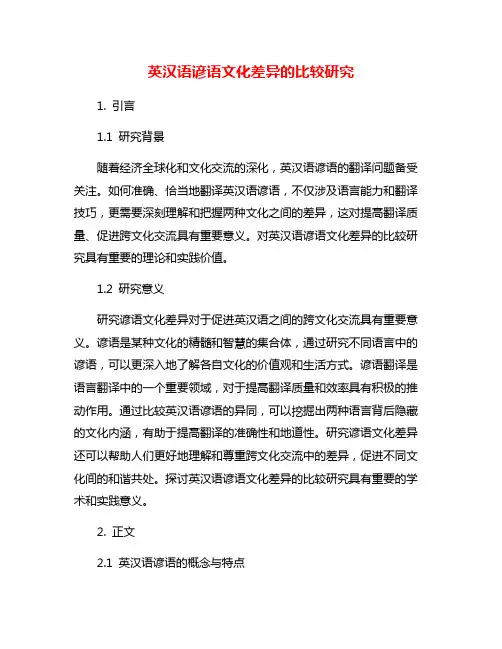
英汉语谚语文化差异的比较研究1. 引言1.1 研究背景随着经济全球化和文化交流的深化,英汉语谚语的翻译问题备受关注。
如何准确、恰当地翻译英汉语谚语,不仅涉及语言能力和翻译技巧,更需要深刻理解和把握两种文化之间的差异,这对提高翻译质量、促进跨文化交流具有重要意义。
对英汉语谚语文化差异的比较研究具有重要的理论和实践价值。
1.2 研究意义研究谚语文化差异对于促进英汉语之间的跨文化交流具有重要意义。
谚语是某种文化的精髓和智慧的集合体,通过研究不同语言中的谚语,可以更深入地了解各自文化的价值观和生活方式。
谚语翻译是语言翻译中的一个重要领域,对于提高翻译质量和效率具有积极的推动作用。
通过比较英汉语谚语的异同,可以挖掘出两种语言背后隐藏的文化内涵,有助于提高翻译的准确性和地道性。
研究谚语文化差异还可以帮助人们更好地理解和尊重跨文化交流中的差异,促进不同文化间的和谐共处。
探讨英汉语谚语文化差异的比较研究具有重要的学术和实践意义。
2. 正文2.1 英汉语谚语的概念与特点英汉语谚语是一种常见的语言表达方式,在英语和汉语中都有着丰富的谚语资源。
谚语是人们在长期生活实践中总结出来的具有智慧和哲理的短小句子,具有较高的文化内涵和智慧。
英汉语谚语在表达形式、文化内涵和使用场景等方面存在一些共同点和区别。
英汉语谚语都是用简练的语言形式表达深刻的哲理和经验。
它们在几个词汇中蕴含着丰富的含义,能够直观地传达人们的思想和观念。
英语谚语"Actions speak louder than words"传达了实际行动比空谈更有力量的道理;而汉语谚语"知己知彼,百战百胜"则强调了了解对手和自己才能取得胜利。
英汉语谚语在文化内涵方面存在一定的差异。
英语谚语多以自然、动物、日常生活等为载体,强调实用性和生活智慧;而汉语谚语则更注重历史、文化、宗教等方面,反映了中国传统文化的思想和价值观。
英语谚语"A rolling stone gathers no moss"比喻不安定的生活方式不利于积累财富和成就;而汉语谚语"塞翁失马,焉知非福"则讲述了一个塞翁因失马而获福的故事,强调了看问题要有全面的思考。

英汉谚语的文化差异及翻译第一篇:英汉谚语的文化差异及翻译英汉谚语的文化差异及翻译谚语在字典中的定义是短小精练的民间智慧警句,一般形式严谨,经常包括鲜明的形象和使人难忘的韵律。
谚语多风趣幽默,饱含哲理,因而经得起时间的考验,广为流传。
英汉两种语言历史悠久,包含着大量的谚语,由于地理、历史、宗教信仰、生活习俗等方面的差异,英汉谚语承载着不同的民族文化特色和文化信息,它们与文化传统紧密相连,不可分割。
1.与基督教有关的谚语宗教是谚语的重要来源之一。
汉语的谚语“平时不烧香,临时抱佛脚”明显与曾在中国广泛流传的佛教有关。
包括英语在内的西方国家的主要宗教是基督教。
许多英语谚语和基督教有着这样那样的关系是十分自然的。
例:Man proposes, God disposes.谋事在人,成事在天。
God help those who help themselves.自助者天助之。
God sends meat and the devil sends cooks.上帝赐给食物,魔鬼派来厨师。
Each cross hath its own inscription.每个十字架都有自己的铭文。
以上谚语明显与基督教有关,因为谚语里出现的“上帝”或“十字架”都是基督教的象征。
非常有意思的一点是英语中的God经常与汉语中的“天”相对应。
基督教徒崇拜上帝,英语中God save the Queen是家喻户晓的句子。
当一个说英语的人突然从紧张、焦急、或压力下解脱出来的时候,会脱口而出:Thank God!中国人崇拜“天”。
中国古代的皇帝是“天子”,运气好的人是“天之骄子”。
只要好心人得到报答而恶人受到惩罚,我们就会说“苍天有眼”英国人和中国人都要有寻求帮助的对象。
只是说英语的人找的是上帝,而中国人找的是“天”而已。
2.出自《圣经》和英语文学巨著里的谚语《圣经》是最广为阅读的书之一,也是包括英语国家在内的西方世界最有影响力的宗教作品。
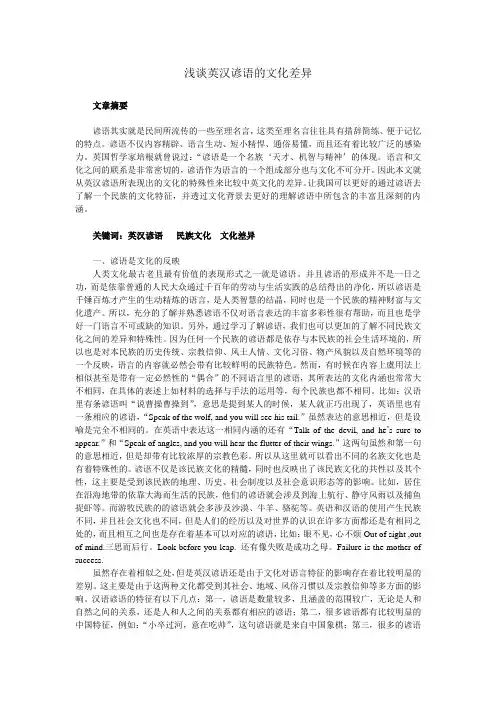
浅谈英汉谚语的文化差异文章摘要谚语其实就是民间所流传的一些至理名言,这类至理名言往往具有措辞简练、便于记忆的特点。
谚语不仅内容精辟、语言生动、短小精悍、通俗易懂,而且还有着比较广泛的感染力。
英国哲学家培根就曾说过:“谚语是一个名族‘天才、机智与精神’的体现。
语言和文化之间的联系是非常密切的,谚语作为语言的一个组成部分也与文化不可分开。
因此本文就从英汉谚语所表现出的文化的特殊性来比较中英文化的差异。
让我国可以更好的通过谚语去了解一个民族的文化特征,并透过文化背景去更好的理解谚语中所包含的丰富且深刻的内涵。
关键词:英汉谚语民族文化文化差异一、谚语是文化的反映人类文化最古老且最有价值的表现形式之一就是谚语。
并且谚语的形成并不是一日之功,而是依靠普通的人民大众通过千百年的劳动与生活实践的总结得出的净化,所以谚语是千锤百炼才产生的生动精炼的语言,是人类智慧的结晶,同时也是一个民族的精神财富与文化遗产。
所以,充分的了解并熟悉谚语不仅对语言表达的丰富多彩性很有帮助,而且也是学好一门语言不可或缺的知识。
另外,通过学习了解谚语,我们也可以更加的了解不同民族文化之间的差异和特殊性。
因为任何一个民族的谚语都是依存与本民族的社会生活环境的,所以也是对本民族的历史传统、宗教信仰、风土人情、文化习俗、物产风貌以及自然环境等的一个反映,语言的内容就必然会带有比较鲜明的民族特色。
然而,有时候在内容上虞用法上相似甚至是带有一定必然性的“偶合”的不同语言里的谚语,其所表达的文化内涵也常常大不相同,在具体的表述上如材料的选择与手法的运用等,每个民族也都不相同。
比如:汉语里有条谚语叫“说曹操曹操到”,意思是提到某人的时候,某人就正巧出现了,英语里也有一条相应的谚语,“Speak of the wolf, and you will see his tail.”虽然表达的意思相近,但是设喻是完全不相同的。
在英语中表达这一相同内涵的还有“Talk of the devil, and he’s sure to appear.”和“Speak of angles, and you will hear the flutter of their wings.”这两句虽然和第一句的意思相近,但是却带有比较浓厚的宗教色彩。
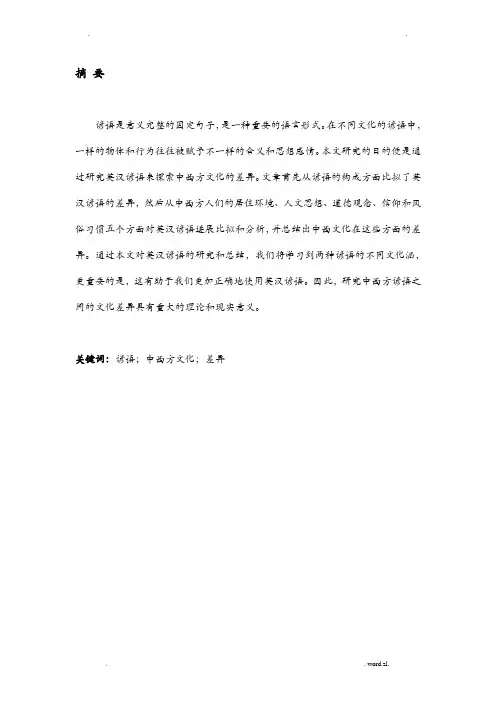
摘要谚语是意义完整的固定句子,是一种重要的语言形式。
在不同文化的谚语中,一样的物体和行为往往被赋予不一样的含义和思想感情。
本文研究的目的便是通过研究英汉谚语来探索中西方文化的差异。
文章首先从谚语的构成方面比拟了英汉谚语的差异,然后从中西方人们的居住环境、人文思想、道德观念、信仰和风俗习惯五个方面对英汉谚语进展比拟和分析,并总结出中西文化在这些方面的差异。
通过本文对英汉谚语的研究和总结,我们将学习到两种谚语的不同文化涵,更重要的是,这有助于我们更加正确地使用英汉谚语。
因此,研究中西方谚语之间的文化差异具有重大的理论和现实意义。
关键词:谚语;中西方文化;差异AbstractProverb is a plete sentence,and it is an important form of language. In the different proverbs that from different culture, the same things and the same behavior show represent different means and different feelings. The paper is aimed to explore the cultural differences between Chinese and Western proverbs. Firstly, the author analysis the differences from their unique characteristics, then summarizes the differences of living environment, humanistic idea, moral views, religious beliefs and social customs between Chinese culture and Western one by paring and analyzing Chinese proverbs and English ones. Through the study and summary of this paper we will learn the different cultural connotation from different culture. What’s more, we will use Chinese and Western proverbs more easily and more accurately. So it is no exaggeration to say that a parison between English and Chinese proverbs is of great practical and theoretical significance.Key words: Proverbs; Western and Chinese culture; differencesAcknowledgementsI would like to express my gratitude to all those who helped me during the writing of this thesis. I gratefully acknowledge the help of my supervisor, Xia Li, who has offered me valuable suggestions in the academic studies. Without her encouragement, insightful criticism and gracious guidance, the pletion of this thesis would not have been possible.I also owe a special debt of gratitude to all the teachers in Foreign Languages School, from whose devoted teaching and enlightening lectures I have benefited a lot and academically prepared for the thesis.I should finally like to express my gratitude to my beloved parents who have always been helping me out of difficulties and supporting without a word of plaint.OutlineⅠ. IntroductionⅡ. The Characteristics and Impact of ProverbsA. The Unique Characteristics of Proverbs1. Form of Characters2. Sentence Pattern3. Rhetorical DevicesB. The Position and Role of Proverbs in the Real Life Ⅲ. The cultural differences of Chinese and Western ProverbsA. Proverbs of Living EnvironmentB. Proverbs of Humanistic IdeaC. Proverbs of Moral Views1. The Attitude Towards Reputation2. The View of Love3. Filial Duty4. The Attitude Towards WomanD. Proverbs of Religious Beliefs1. God and no God2. The Idea of Equality and GradeE. Proverbs of CustomⅣ.ConclusionCultural Differences between Chinese and English Proverbs Ⅰ. IntroductionDuring the etymology, proverb is defined as a settled saying acpanied with the long history. In the modern version of the Dictionary, proverbs indicated these briefly, popular and meaningful sentences which are popular in folk among traditional social of China. In western, many English dictionaries have the analogous definition which is popular short saying with words of advice or warning. There are many proverbs in our daily life and be used very popular during our daily life.“Genius wit and spirit of a nation are discovered by their proverbs.〞said by Bacon, a well-known British writer. Every nation has abundant proverbs in their own native language, which were using reflect their life experience, thoughts and feelings.Ⅱ. The Characteristics and Impact of ProverbsA.The Unique Characteristics of ProverbsAs a quintessence of native language, proverbs have many unique characteristic which different from other language forms. Next we will introduce its characteristics through the three aspects include characters form, sentence pattern structure and rhetorical device.1. Form of CharactersProverb is summarizes of labor practice of the masses, it has a heavy flavor of life. The English and Chinese proverbs have regular sentence pattern and shapely syllable, it selects the words is very refined. Proverbs can express luxuriant idea content with highly condensed language. It has highly ability of generalizing, which aimed at reflect a profound moral vividly. It displayed mainly follow the three points:First of all, proverbs always using small amount of words and flat structure to press the abundant content. These sentences, which are dapper, crisp and finger-popping, embodies the language feature of English and Chinese native. For example: Live and learn〔活到老,学到老〕;After rain es sunshine〔雨过天晴〕.In our native proverbs, there are also many examples like: 物以类聚,人以群分;两人伴,三人散。
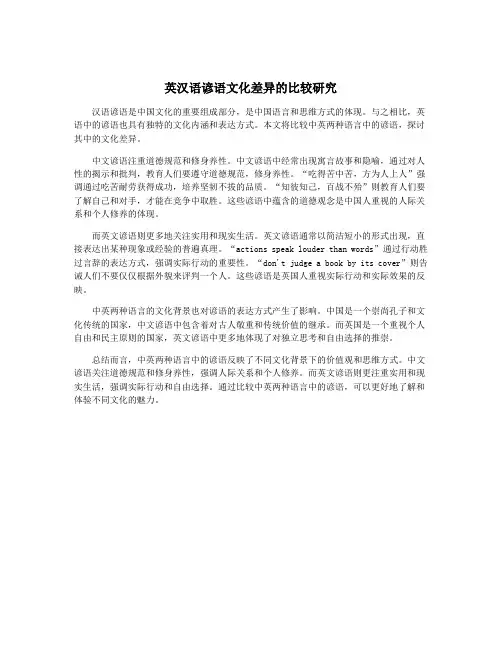
英汉语谚语文化差异的比较研究汉语谚语是中国文化的重要组成部分,是中国语言和思维方式的体现。
与之相比,英语中的谚语也具有独特的文化内涵和表达方式。
本文将比较中英两种语言中的谚语,探讨其中的文化差异。
中文谚语注重道德规范和修身养性。
中文谚语中经常出现寓言故事和隐喻,通过对人性的揭示和批判,教育人们要遵守道德规范,修身养性。
“吃得苦中苦,方为人上人”强调通过吃苦耐劳获得成功,培养坚韧不拔的品质。
“知彼知己,百战不殆”则教育人们要了解自己和对手,才能在竞争中取胜。
这些谚语中蕴含的道德观念是中国人重视的人际关系和个人修养的体现。
而英文谚语则更多地关注实用和现实生活。
英文谚语通常以简洁短小的形式出现,直接表达出某种现象或经验的普遍真理。
“actions speak louder than words”通过行动胜过言辞的表达方式,强调实际行动的重要性。
“don't judge a book by its cover”则告诫人们不要仅仅根据外貌来评判一个人。
这些谚语是英国人重视实际行动和实际效果的反映。
中英两种语言的文化背景也对谚语的表达方式产生了影响。
中国是一个崇尚孔子和文化传统的国家,中文谚语中包含着对古人敬重和传统价值的继承。
而英国是一个重视个人自由和民主原则的国家,英文谚语中更多地体现了对独立思考和自由选择的推崇。
总结而言,中英两种语言中的谚语反映了不同文化背景下的价值观和思维方式。
中文谚语关注道德规范和修身养性,强调人际关系和个人修养。
而英文谚语则更注重实用和现实生活,强调实际行动和自由选择。
通过比较中英两种语言中的谚语,可以更好地了解和体验不同文化的魅力。
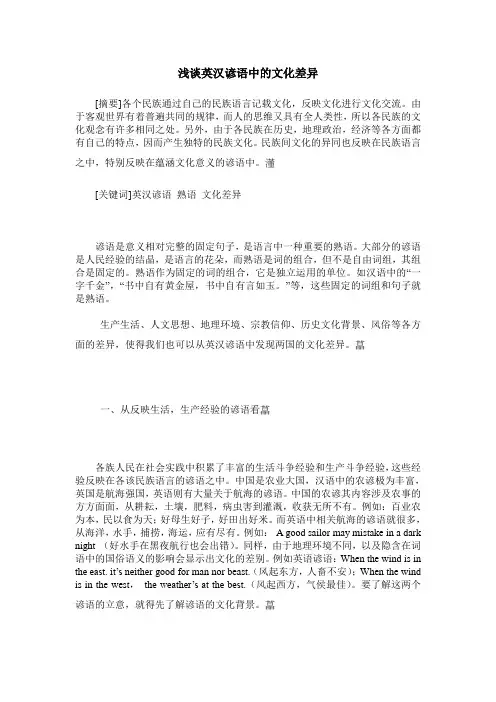
浅谈英汉谚语中的文化差异[摘要]各个民族通过自己的民族语言记载文化,反映文化进行文化交流。
由于客观世界有着普遍共同的规律,而人的思维又具有全人类性,所以各民族的文化观念有许多相同之处。
另外,由于各民族在历史,地理政治,经济等各方面都有自己的特点,因而产生独特的民族文化。
民族间文化的异同也反映在民族语言之中,特别反映在蕴涵文化意义的谚语中。
[关键词]英汉谚语熟语文化差异谚语是意义相对完整的固定句子,是语言中一种重要的熟语。
大部分的谚语是人民经验的结晶,是语言的花朵,而熟语是词的组合,但不是自由词组,其组合是固定的。
熟语作为固定的词的组合,它是独立运用的单位。
如汉语中的“一字千金”,“书中自有黄金屋,书中自有言如玉。
”等,这些固定的词组和句子就是熟语。
生产生活、人文思想、地理环境、宗教信仰、历史文化背景、风俗等各方面的差异,使得我们也可以从英汉谚语中发现两国的文化差异。
一、从反映生活,生产经验的谚语看各族人民在社会实践中积累了丰富的生活斗争经验和生产斗争经验,这些经验反映在各该民族语言的谚语之中。
中国是农业大国,汉语中的农谚极为丰富,英国是航海强国,英语则有大量关于航海的谚语。
中国的农谚其内容涉及农事的方方面面,从耕耘,土壤,肥料,病虫害到灌溉,收获无所不有。
例如:百业农为本,民以食为天;好母生好子,好田出好米。
而英语中相关航海的谚语就很多,从海洋,水手,捕捞,海运,应有尽有。
例如:A good sailor may mistake in a dark night (好水手在黑夜航行也会出错)。
同样,由于地理环境不同,以及隐含在词语中的国俗语义的影响会显示出文化的差别。
例如英语谚语:When the wind is in the east. it’s neithe r good for man nor beast.(风起东方,人畜不安);When the wind is in the west,the weather’s at the best.(风起西方,气侯最佳)。
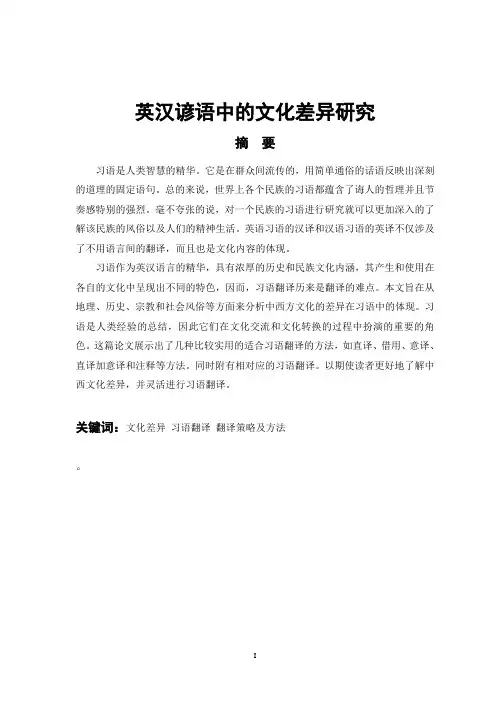
英汉谚语中的文化差异研究摘要习语是人类智慧的精华。
它是在群众间流传的,用简单通俗的话语反映出深刻的道理的固定语句。
总的来说,世界上各个民族的习语都蕴含了诲人的哲理并且节奏感特别的强烈。
毫不夸张的说,对一个民族的习语进行研究就可以更加深入的了解该民族的风俗以及人们的精神生活。
英语习语的汉译和汉语习语的英译不仅涉及了不用语言间的翻译,而且也是文化内容的体现。
习语作为英汉语言的精华,具有浓厚的历史和民族文化内涵,其产生和使用在各自的文化中呈现出不同的特色,因而,习语翻译历来是翻译的难点。
本文旨在从地理、历史、宗教和社会风俗等方面来分析中西方文化的差异在习语中的体现。
习语是人类经验的总结,因此它们在文化交流和文化转换的过程中扮演的重要的角色。
这篇论文展示出了几种比较实用的适合习语翻译的方法,如直译、借用、意译、直译加意译和注释等方法。
同时附有相对应的习语翻译。
以期使读者更好地了解中西文化差异,并灵活进行习语翻译。
关键词:文化差异习语翻译翻译策略及方法。
AbstractProverbs are the most popular language and the embodiment a general truth and the wisdom of a nation. Their meanings are in deep and rhythm. It is not an exaggeration to say that to explore the proverbs of a certain language is one of the feasible approaches to get into the inside of that nation’s people and spiritual life. The English-Chinese and Chinese-English proverb translation involves not only the transfer of language but also the transmission of culture.As the essence of English and Chinese language, proverbs or set phrases have strong historical and cultural contents, whose emergence and use demonstrate different characteristics in its own culture. Therefore, proverb translation has always been the difficulty for translation. The present thesis attempts to study cultural differences between western and eastern proverbs from perspectives like geographic, historical, religious and social customs. Since proverbs are the summary of the common people’s experiences,they play a decisive role in promoting different cultural exchange and cultural transmission.More importantly, this thesis is going to propose several methods for proverbs translation such as metaphrase, borrowing, free translation, metaphrase plus free translation and the use of notes. Practical proverb translation examples and methods are proposed accordingly. It’s hoped that this will benefit learners and readers in their better understanding of cultural differences and skillful translation of proverbs.Key words:cultural differences; proverb translation; translation strategies and methodsTable of Contents摘要 (I)Abstract (II)1 Introduction (1)2 Definition (2)2.1 The definition of proverb (2)2.2 The Definition of cultural dDifferences (2)3. The Analysis of East-West Cultural Differences (3)3.1 Geographic differences (4)3.2 Historical differences (5)3.3 Religious differences (5)3.4 Social customs differences (6)4. Translation Strategies and Methods (7)4.1 Metaphrase (7)4.2 Borrowing (7)4.3 Free Translation (8)4.4 Metaphrase plus free translation (8)4.5 The use of notes (9)5. Conclusion (10)References (11)1 IntroductionLanguage is the carrier of culture, which reflects the culture it represents. Set phrase or proverb is an indispensable essence part of culture, which contains very rich historical, social, religious and cultural contents. Actually, proverbs are seen as the most important too for people’s communication which can be treated as an indispensable part of culture and is influenced by culture in return. Without culture, language would be insignificant. Moreover, proverbs are considered to be the most popular saying in the society and the wisdoms of a nation which reveals the people’s mind and wisdom in pieces of words. Without proverbs, language would lack spirit and color. A concentrated reflection of various rhetorical means and a mirror of the historical and cultural conceptions of a society are revealed in proverbs.Proverbs between eastern and western countries vary differently due to their different ways of living, ways of thinking, different historical development and different cultures. Therefore, proverb translation has always been the difficulty for translation. Nevertheless, the successful translation of proverbs is of vital importance in inter-lingual and inter-cultural communication between China and western countries, and east-west cultural differences are among the largest barriers of proverb translation. It is thus very important and necessary for us to probe into the west-east cultural differences and come up with practical proverb translation strategies and methods in order to help learners and readers better understand the cultural differences and better translate proverbs.The present thesis attempts to study cultural differences between western and eastern proverbs from perspectives like geographic, historical, religious and social customs. Since proverbs are the summary of the common people’s experiences,they play a decisive role in promoting different cultural exchange and cultural transmission.More importantly, this thesis is going to propose several methods for proverbs translation such as metaphrase, borrowing, free translation, metaphrase plus free translation and the use of notes.2. Definition2.1 The definition of proverbProverb or set phrase is the crystal of language accumulated and extracted during people’s long-time practice and use. Proverbs often come from ancient classics, famous masterpieces, historical stories and folktales, which contain rich cultural information and have strong national characteristics. Proverb has the characteristics of vividness, profoundness, conciseness, humor and meaningfulness. Even within a single language community, proverb, and the extent to which it is used, tends to vary widely across social, ethnic, economic, and geographic strata. Proverb may fall into disuse over time; sometimes, however, it grows more and more common until it becomes the dominant way of saying something, at which time it usually comes to be regarded as mainstream, acceptable language, although in the case of taboo words there may not be an expression which is considered mainstream or acceptable. Numerous proverb terms pass into informal mainstream speech, and sometimes into formal speech, though this may involve a change in meaning or usage.Proverb often involves the creation of new meanings for existing words. It is common for such novel meanings to diverge significantly from the standard meaning.A proverb is a simple and concrete saying, popularly known and repeated, that expresses a truth based on common sense or the practical experience of humanity. They are often metaphorical. A proverb that describes a basic rule of conduct may also be known as a maxim.Proverbs are often borrowed from similar languages and cultures, and sometimes come down to the present through more than one language. Both the Bible and Medieval Latin have played a considerable role in distributing proverbs across Europe, although almost every culture has examples of its own.2.2 The definition of cultural differencesThere are different meanings to the word “culture”. Sometimes, people who know about music, art, literature are thought to be cultured. However, to an anthropologist, the word “culture” means all the ways that a group of people think, feel, eat and dress. TheLongman Dictionary of Contemporary English gives such an explanation of culture: the customs, beliefs, art, music, and all the other products of human thought made by a particular group of people at a particular time. The linguistic difference that informs any cultural performance is dramatized in the common semiotic account of the disjuncture between the subject of a proposition and the subject of enunciation, which is not represented in the statement but which is the acknowledgment of its discursive and address, its cultural, its reference to a present time and a specific space. The pact of interpretation is never simply an act of communication between the I and the you designated in the statement. The production of meaning requires that these two places be mobilized in the passage through a Third Space, which represents both the general conditions of language and the specific implication of the utterance in a performative and institutional strategy of which it cannot “in itself” be conscious. What this unconscious relation introduces is ambivalence in the act of interpretation According to the famous translator Eugene Nida, culture is “the totality of beliefs and practices of a society”. He also holds that “Nothing is of greater strategic importance than the language through which its beliefs are expressed and transmitted and by which most interaction of its members take place.”Therefore it is obvious that cultural differences mean the differences in histories, religions, cultures, social beliefs and customs, etc. For instance, when people die, different cultures deal with their bodies differently. Sometimes bodies are burned; sometimes bodies are buried under the ground. In many cultures in the past, people were buried with food, weapons, and other things that might be useful in the next life. For example, the ancient Egyptians buried people with little human figures which were from clay. These clay figures were intended to work the death person in the other world.From above, we can see that cultures vary differently from one culture to another. There are many factors underlying in cultural differences, the author of this paper will conduct further analysis later in the following.3. The Analysis of East-West Cultural DifferencesThere are a number of cultural differences between China and other westerncountries, but the differences can be overcome in inter-cultural communications. Having a good command of the factors about the differences would help people better understand the language and the culture, so to perform successful communications. This paper has mainly chosen four east-west cultural differences: geographic differences, historical differences, religious differences and social customs differences. In the following, this paper will further discuss the main four differences respectively.3.1 Geographic differencesPeople in different countries live in different geographic environments, thus different cultures and different proverbs were formed in the process of laboring and struggling with nature. A certain culture exists in a certain terrain; inevitably, it reflects the natural and geographic features of the area. For this reason, when people use natural sights or objects to express themselves, there would be obvious differences. What’s more, people in different cultures hold different attitudes towards different natural phenomenon relevant to their living conditions, so the expressions of proverbs are also quite different.For example, China has long been an agricultural country with a vast land, so it has many expressions or proverbs with land or agriculture, such as “七十二行,庄稼人头一行”, “百叶农为本,民以食为天”, “地不翻,苗不欢”, “种田不用问,用好水和粪” and so on. However, Britain is an island country surrounded by vast sea, so it has many expressions or proverbs related to boats or seas, such as “The best fish swim near the bottom” (好鱼沉水底), “to go with the stream” (随波逐流), “The good seaman is known in bad weather”(要识还海员,须凭坏天气), “There’s as good fish in the sea as ever come out of it” (有了大海,害怕没鱼), “A man may lead a horse to the water, but he can’t make him drink” (牛不喝水,按不低头) and so on. These kinds of examples are numerous. Also, there are many proverbs peculiar to specific geographic areas, for instance, in English “bring coal to Newcastle”(多此一举), since Newcastle is a place abundant in coal. Meanwhile, there are similar proverbs in Chinese, such as “边收边耕,叶草不生”, “好树结好桃,好种出好苗”, “春风不刮,春芽不发” and so on.The totally different geographical differences of the east and west are responsible for the different cultural values embodied in the proverbs of the two languages.3.2 Historical differencesApart from geographic differences, historical differences are also of great importance. A certain culture is formed through a nation’s history, so when discussing cultural differences, historical differences cannot be neglected. Different countries have different historical developments, stories, legends, allusions and so on. For example, throughout the history, Chinese people define themselves as the descendents of “Yandi and Huangdi Emperors” the “Dragon” and the “Cathay”; so an proverb was “炎黄子孙”. There are also proverbs relevant to wars, persons, etc. such as “唱空城计”, “败走麦城”, “东施效颦”, “名落孙山” and so on. In English, there are also proverbs or expressions related to wars, persons peculiar in its own culture, such as “to meet one’s Waterloo” to mean failure, “a Trojan horse” to mean potential dangers, “Achilles’ heel” to mean one’s fatal weakness, the week or vulnerable point of a person, an organization, a country and “Pandora’s box” to mean the root of evils. There are boundless examples like this. The historic value of a certain culture is unique; people should pay special attention to it when engaged in inter-cultural communication and proverb translation.In brief, both East and West have its own historic field and literary works to reflect their proverbs. Only if the translator translates proverbs well, can the exact meaning will be transmitted.3.3 Religious differencesReligious belief is one aspect of human thought, which has great influence on culture. In many western countries, particularly in English-speaking countries, people believe in Christianity. They believe that God is all mighty. So there are many proverbs related to their belief. For example, “A tree is known by its fruit” (观果实可知树,观其行可知人), “God help those who help themselves”(自助者天助). In addition, the Bible has greatly affected the western culture, and some proverbs are derived from Bible, such as “the forbidden fruit” (禁果), “as poor as Job” (一贫如洗), “eye for eye and teeth for teeth” (以眼还眼,以牙还牙), and so on. While Chinese culture, on the other hand, was mainly influenced by Confucianism, Taoism and Buddhism. Proverbs like “平时不烧香,临时抱佛脚”“泥菩萨过河,自身难保” reflect Buddhism; “乐极生悲”“脱胎换骨”“回光返照” are derived from Taoism; while “平安是福” is from Confucianism. Religion is a complex factor in inter-cultural activities, thus it cannot be ignored for its profound influence on cultures.From the analysis proverbs above, we can infer that God is powerful in Christianity and Buddha is mighty in Buddhism. The Chinese people adore the Buddha and the westerners show respect to the God.3.4 Social customs differencesSocial customs also play an important role in east-west cultural differences, as it embodies a nation’s history and value. Countries with different social customs have different beliefs, values and different national emotions. Just take China and English-speaking countries as an example, in China, horse is regarded as loyal and patient, so Chinese people treat horses as friends. There are many favorable proverbs related to horses, such as “马到成功”, “马首是瞻”. While Westerners regarded horses as their companion in their life as they can reveal from the proverbs like “a horse stumbles that has four legs”(everyone will make mistakes in one day), “it is too late to lock the stable door after the horse has bolted”(one needs to make preparation in advance, otherwise, he will suffer incurable loss).Dog is a low-down animal in Chinese culture, so proverbs related to dogs are derogatory, such as “狗嘴里吐不出象牙”, “狗咬耗子,多管闲事”,“狗咬吕洞宾,不识好人心”etc. On the contrary, English people regard dogs as faithful friends, so English proverbs relevant to dogs are positive. For instance, when they say someone is lucky, they would say “a lucky dog”; however, proverbs related to horses are not always good, such as “pay for a dead horse” means waste money.For another example, Chinese and English people hold different attitudes towards “dragon”. Chinese people think dragon as auspicious and precious, thus proverbs related to dragon are always predatory, such as “望子成龙”, “龙凤呈祥”and “乘龙快婿”. While western people often regard dragon as evil and ferocious, thus proverbs related to dragon are always negative, such as “chase the dragon” means taking drugs.Social customs have much to do with the national characteristic of proverbs. From the analysis above, we may find that people’s different attitudes towards the sameanimals are quite different, as the horse and the dog.4. Translation Strategies and MethodsFrom above analysis, we have already known the four main cultural differences between proverbs of China and western countries. In this chapter, the author will come up with some strategies and methods for proverbs translation. We summarized five main translation strategies and methods, namely: metaphrase, borrowing, free translation, the method of metaphrase combined with free translation and use of notes, in the hope to help learners and readers better translate proverbs, thus to ensure excellent translation texts and successful communications.4.1 MetaphraseMetaphrase is a method to translate Chinese proverbs directly into English. It is able to keep the meaning, form, and grammatical structure of the source language when adopting this method. Nevertheless, the method of metaphrase doesn’t mean translate the source proverbs word by word. For example, the Chinese proverb “三人行,必有我师”can be divided into two parts: “三人行” and “必有我师”. Their counterparts in English are “three men” and “teach”, so when translating “三人行,必有我师”, translators can adopt the method of metaphrase to translate it like “When there are three men walking together, one of them is bound to be able to teach me something”. For another examples, “路遥知马力,日久见人心” (A long road test a horse ‘s strength and a long talks proves a man’s heart), “井干方知水可贵”(We never know the worth of water till the well is dry), “吠犬不咬人” (Barking dogs do not bite) and so on.When using metaphrase method, the translator should follow several rules. The first is that the translation should transfer the message from the source text completely. The second is that the translation should accord with the characteristics of the target language. The last but not the least, the translation shouldn’t evoke incorrect imagination to readers.4.2 BorrowingBoth Chinese and English have lots of similar proverbs. Some Chinese and English proverbs have similar meanings and forms. Therefore, translators can use the method of borrowing when translating proverbs. For example, some Chinese proverbs and Englishproverbs have similar or underlying meaning, and they also have similar image or metaphor, such as the Chinese proverb “吃一堑,长一智” and the English proverb “A fall into the pit, a gain into your wit” have the same underlying meaning. The proverb “隔墙有耳,窗外岂能无人”and its translation “Wall have ears, and outside the window is there not a man?”Not only have the same metaphor meaning, but also have similar image. Some Chinese proverbs and English proverbs do not have the same image, but they do have the same metaphor meaning. For example, “山穷水尽” in Chinese means a hopeless situation. The English proverb “at the end of one’s rope” also means somebody has done all they could but still couldn’t find a way to solve the problem. Thus “at the end of one’s rope”is a preferred translation for “山穷水尽”. Using the method of borrowing, the target readers would have a sense of familiarity, which makes it easier for them to understand the translation and the culture.4.3 Free translationFree translation is the method mostly adopted when translators cannot translate the proverbs literally. For example, if translators use the method of metaphrase when translating the Chinese proverb “开门见山”, the translation would be “to open the door and see the mountain”, which is very awkward. In order to translate the original message more precisely, free translation should be adopted, since it focuses more on meaning. Then the proverb “开门见山” can be translated into “to come straight to the point”. The Chinese proverb “完璧归赵”has a metaphor meaning, which means give something back without a tiny damage. If we directly translate the proverb like “return the jade intact to the state of Zhao.”, then the metaphor meaning is lost. It’d better be translated as “return something to its owner in perfect”. There are also numerous other examples, such as “refuse to be convinced until faced with grim reality” (不见棺材不落泪), “stay out of things that don’t concern you” (井水不犯河水), “more hands, less work done” (一个和尚挑水吃,两个和尚抬水吃,三个和尚没水吃), “吹毛求疵” ( to pick a hole in one’s coat), “生灵涂炭” (to plunge the people into misery and suffering), and so on.4.4 Metaphrase plus free translationThere exist cases that either metaphrase or free translation can express the meaningof the source proverbs properly. At this moment, the translator could combine the method of metaphrase with free translation. For instance, the Chinese proverb “垂涎三尺”, “垂涎” can be directly translated like “mouth waters”, but “三尺” cannot be translated just as “three feet”. Or else, readers would be confused with the numbers. For this reason, translators can metaphrase the first part and freely translate the second part. The translation for “垂涎三尺” is “The mouth waters copiously”. For another example, “怨声载道” in Chinese, “怨声”can be directly transferred as “complaints”or “discontents”, but “载道”cannot be metaphrased as “fill the road”. Actually, “载道”can be freely translated as “everywhere”. Thus this proverb can be translated like “Complaints are heard everywhere”. Also, the proverb “走马观花” can be translated into “look at flowers while riding on the back of a galloping horse—give a cursory glance.”By combining these two methods, we can on the one hand maintain certain form or image of the source text, and on the other hand maintain the meaning.4.5 The use of notesThe last method of proverb translation in this paper is the use of notes. Strictly speaking, the use of notes can’t be deemed as a method of translation; however, how well translators deal with it determines the quality of the translation. Most Chinese and English proverbs that need to use notes in translating are derived from myths, allusions or historical stories, which have strong historical and cultural background. For example, “叶公好龙” can be translated as “Lord Sheh’s love of dragons” (Note: Lord Sheh was so fond of dragons that he adorned his whole palace with drawings and carvings of them. But when a real dragon heard of his infatuation and paid him a visit, he was frightened out of his wits). For another instance, “东施效颦”, “东施” was an ugly girl, and “颦” refers to Xishi—one of the four most beautiful girls in ancient China. This proverb contains a historical story. Dongshi wanted to be a beautiful girl just like Xishi, so she imitated Xishi. When translating this proverb, translators should use notes for explanations of readers. However, in most cases, notes are long. So it is recommended to use notes only when necessary.In this part, the paper has mainly discussed five common and different strategies andmethods of proverbs translation. Each strategy should be employed in suitable situation in an appropriate manner.5. ConclusionThis paper makes an attempt to analyze the cultural differences between Chinese and English proverbs, as well as translation strategies and methods; which aims to figure out the influences cultural differences have on proverbs translation, and comes up with some practical translation strategies and methods of proverbs. It is hoped that this paper will provide some enlightenments and suggestions for learners and readers. Owing to the cultural differences, it is difficult for translators to find the best method in proverb translation. All the four methods in the thesis are not the ideal or correct solutions and there may exist some better methods to be found. After all, they may treat as a reference for translators. Furthermore, the study of Chinese proverbs and the appropriate translation methods are helpful to promote the cultural exchange between English and Chinese.In order to promote interaction among different cultures and to ensure successful communications, special attention should be paid to proverb translation since it is an indispensable part of a language which contains rich cultural information. When translating proverbs, translators should know well of the foreign histories and customs, master a lot of similar foreign proverbs or expressions, have a good command of the source language and be flexible and skillful in the use of proverb translation strategies and methods. Only in this way can translators render better translation whether in form or meaning or both.Finally, it should be acknowledged that what has been done in this thesis may not be a final solution to the problem. Rather, it is hoped to be helpful for the translation of Chinese and English proverbs and provide some information for further relevant researches.正文字数要4000字左右,你的严重不足。

英汉语谚语文化差异的比较研究摘要:谚语,顾名思义就是广泛流传于民间的言简意赅的短语,多数反映了劳动人民的生活实践经验,而且一般都是经过口头传下来的。
句式也大多是口语形式的通俗易懂的短句或韵语。
谚语,不仅是各国文化的重要组成部分,还是人民群众智慧的果实。
汉英谚语历史非常悠久并且数量十分庞大。
本文着重分析了英汉谚语文化存在的相同点与不同点,并分析各自的成因,研究了一些英汉谚语翻译的技巧,最后强调英汉语谚语文化在当今世界各国跨文化交际中的重要性。
关键词:谚语;英汉语对比;跨文化交际一、介绍谚语,是由民间创造、广为流传、言简意赅的较为定性的特殊语句,是广大民众智慧与经验的体现。
因此,谚语一般具有浓厚的民族色彩,可以说,英汉语的谚语都具有结构紧凑、风格独特、寓意深刻,使人印象深刻的特点。
英汉两个民族虽然语言各不相同,文化与风俗习惯也相差甚远,但由于人们的心理与个性的特点存在着共性,因此,英汉语的谚语在内容、形式等诸多方面索要表达的含义都存在着许多共同之处。
然而,有共性就必然存在着差异,由于各国的具体文化与风俗之间存在着不同的背景,因此,英汉语的谚语也存在着差异。
英汉谚语有着类似的文化起源和语言特点,起初也大多来自于民间生活、神话传说、文学作品以及外来语。
二、英汉语谚语文化差异的体现谚语在民间广为流传,多数反映了劳动人民的生活以及实践的经验,随着全球化的发展,中国的学者以及读者有了更多的机会接触和学习外国的谚语,尤其是英语中的谚语。
然而,英汉谚语在很多方面都存在着差异,主要体现在以下的方面。
(一)生活环境的差异生活环境的主要有两个方面,即地理与人文环境之间的差异。
从地理方面的差异来看:地理和气候环境对谚语的形成有着很大的影响,以英国为例,英国人早期大多居住在海边且以捕鱼和航海为生,这种特殊的生活习惯以及居住环境就对其谚语的形成产生了深刻的影响。
例如:“Neverfryafishtillitiscaught.”(鱼没捉到手,不要忙着煎)。
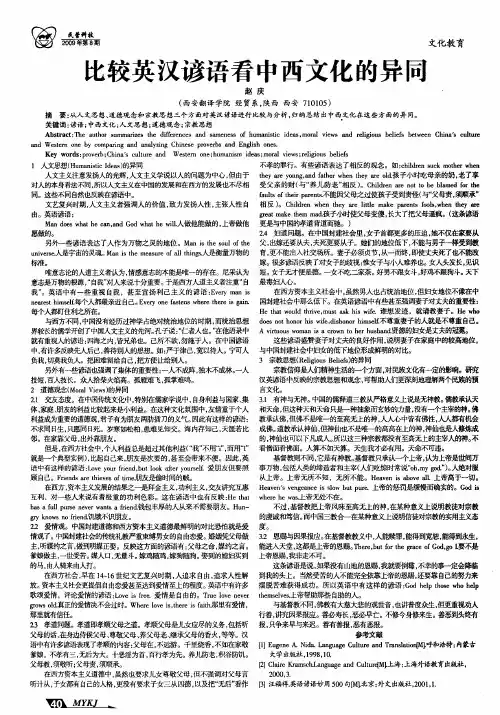
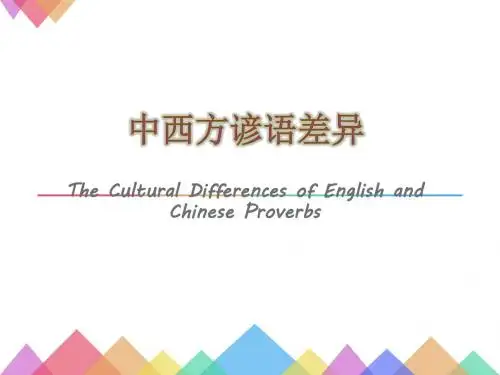
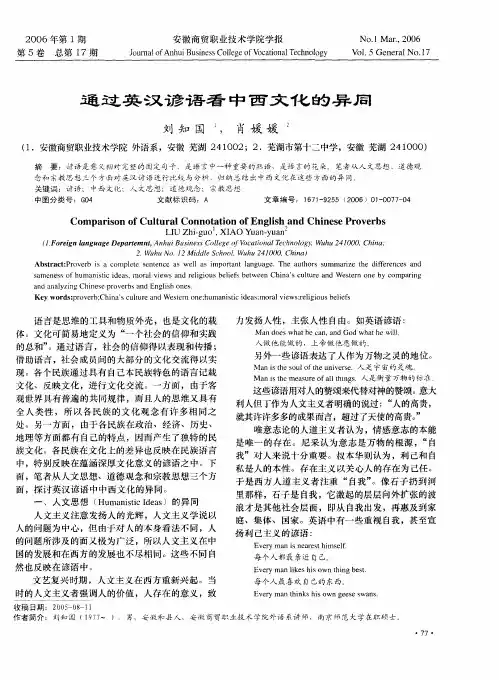
英汉语谚语文化差异的比较研究英汉语谚语是两种不同文化的象征和表达方式。
它们反映了国家的传统、价值观和生活方式。
本文将对英汉语谚语文化差异进行比较研究,以探讨两种文化的异同和背后的文化含义。
在文化含义方面,英汉语谚语也呈现出不同的价值观和生活方式。
在英语中,常用的谚语如“Birds of a feather flock together”,“All that glitters is not gold”等等,强调个人的自由和独立。
而在中文中,谚语像“知足常乐”,“羊毛出在羊身上”则强调的是团结和共同体。
在喻意方面,英汉语谚语也有着显著的差异。
英语谚语强调的是现实主义和个体力量,如“Rome was not built in a day” 反映出的是耐心和毅力。
而中文谚语则更多体现出的是儒家文化的智慧,如“和合共生”,“高瞻远瞩”。
两种文化的语言谚语所包含的文化内涵也有所不同。
在英国,动物和自然现象常被用作比喻,如“Don't count your chickens before they are hatched” 而在中国,则大部分谚语都与人物、历史和哲学思想结合,例如“打铁还需自身硬”。
令人感兴趣的是,在英汉语谚语中,也存在一些相似之处。
比如英语中常用的“Actions speak louder than words” 和中文中的“实事求是”,表达了相同的智慧和价值观。
未来的研究方向包括对更多英汉语谚语的比较分析,探讨谚语背后的文化内涵,并深入研究如何有效地跨文化传播和交流。
希望本文能为对英汉语谚语文化差异感兴趣的读者提供一些有益的启示。
英汉谚语的文化差异及翻译谚语在字典中的定义是短小精练的民间智慧警句,一般形式严谨,经常包括鲜明的形象和使人难忘的韵律。
谚语多风趣幽默,饱含哲理,因而经得起时间的考验,广为流传。
英汉两种语言历史悠久,包含着大量的谚语,由于地理、历史、宗教信仰、生活习俗等方面的差异,英汉谚语承载着不同的民族文化特色和文化信息,它们与文化传统紧密相连,不可分割。
1. 与基督教有关的谚语宗教是谚语的重要来源之一。
汉语的谚语“平时不烧香,临时抱佛脚”明显与曾在中国广泛流传的佛教有关。
包括英语在内的西方国家的主要宗教是基督教。
许多英语谚语和基督教有着这样那样的关系是十分自然的。
例:Man proposes, God disposes.谋事在人,成事在天。
God help those who help themselves.自助者天助之。
God sends meat and the devil sends cooks.上帝赐给食物,魔鬼派来厨师。
Each cross hath its own inscription.每个十字架都有自己的铭文。
以上谚语明显与基督教有关,因为谚语里出现的“上帝”或“十字架”都是基督教的象征。
非常有意思的一点是英语中的God经常与汉语中的“天”相对应。
基督教徒崇拜上帝,英语中God save the Queen是家喻户晓的句子。
当一个说英语的人突然从紧张、焦急、或压力下解脱出来的时候,会脱口而出:Thank God!中国人崇拜“天”。
中国古代的皇帝是“天子”,运气好的人是“天之骄子”。
只要好心人得到报答而恶人受到惩罚,我们就会说“苍天有眼”英国人和中国人都要有寻求帮助的对象。
只是说英语的人找的是上帝,而中国人找的是“天”而已。
2. 出自《圣经》和英语文学巨著里的谚语《圣经》是最广为阅读的书之一,也是包括英语国家在内的西方世界最有影响力的宗教作品。
它也被认为是一部很好的文学作品。
其中的警句、格言已经成为谚语的一个重要组成部分。
英汉谚语的文化差异及翻译一、英汉谚语中所反映的文化差异1起源差异首先,英汉谚语都受到宗教思想的影响,但同中又有异。
英谚受基督教的影响,反映了基督教的伦理道德和行为规范,如:No respecter of persons.(一视同仁);Man propose,God disposes.(谋事在人,成事在天)等,而汉谚则受到“儒”、“释”、“道”三教的影响。
其次,英汉谚语的起源差别还是很大的。
英谚中有大量出自典章及名人的作品中那些脍炙人口的词句,如:Never say die.(永远不要说”死定了”)出自英国小说狄更斯的《匹克威克外传》;而汉语文史学家们则认为汉谚相当一部分出自社会生活和生产实践,如:“远亲不如近邻”是对日常生活经验的总结。
2生存环境的差异谚语的产生与人们的劳动和生活密切相关。
英国是一个岛国,历史上航海业曾一度领先世界;而汉民族在亚洲大陆生活繁衍,人们的生活离不开土地。
3习俗差异汉谚语差异是多方面的,最典型的莫过于在对狗这种动物的态度上。
狗在汉语中是一种卑微的动物。
汉语中与狗有关的谚语大都含有贬意:“狐朋狗党”、“狗急跳墙”、“狼心狗肺”、“狗腿子”等,尽管近些年来养庞物狗的人数大大增加,狗的“地位”似乎有所改变,但狗的贬义形象却深深地留在汉语言文化中。
而在西方英语国家,狗被认为是人类最忠诚的朋友。
英语中有关狗的谚语除了一部分因受其他语言的影响而含有贬义外,大部分都没有贬义。
在英语习语中,常以狗的形象来比喻人的行为。
如:Every dog has his day.(人皆有出头日);Love me, love my dog.(爱屋及乌)等。
learnmewtricks(老人学不了新东西)等等。
形容人“病得厉害”用sickasadog,“累极了”是dog-tired。
与此相反,中国人十分喜爱猫,用“馋猫”比喻人贪嘴,常有亲呢的成份,而在西方文化中,“猫”被用来比喻“包藏祸心的女人”。
4宗教信仰方面与宗教信仰有关的谚语也大量地出在在英汉语言中。
英汉语谚语文化差异的比较研究英汉语言中有很多谚语,它们是人们长期生活实践中总结出来的形象化、含义深刻的话语,体现了一种语言文化的智慧和传承。
然而,由于英汉语言和文化的差异,英汉谚语存在着一些文化差异。
首先,英汉谚语在表达方式上有所不同。
比如,“骑虎难下”是一句中国常用的谚语,意为难以回头或难以扭转,在此谚语中,大量使用了比喻手法,通过比喻虎的性格来形容困境。
而在英国,“a bird in the hand is worth two in the bush”是一句常见的谚语,意为手中一只鸟胜过树上两只鸟,这种表达方式更加直接和简洁,在信息传递上更直接。
其次,英汉谚语在所表现的文化内涵上存在不同。
比如,“萝卜白菜,各有所爱”是一句中文谚语,以食物为隐喻,强调个人喜好的不同;而在英语中则有“different strokes for different folks”的谚语,意思和萝卜白菜类似,但更加注重个人的差异和多元性。
这说明中国的谚语更加注重集体文化的思想,而英国的谚语则更注重个体多样性。
再者,英汉谚语还存在着文化背景与历史传承的差异。
比如,“海阔凭鱼跃,天高任鸟飞”是一句中国传统的谚语,充分表达了人们坚韧不拔的精神和进取的态度。
而在英国,有“when in Rome, do as the Romans do”的谚语,意思是入乡随俗,尊重当地的文化习俗,避免冲突。
这种谚语来自于罗马帝国时期的当地风俗和文化,旨在帮助外来者适应当地环境和习俗。
总之,英汉谚语虽然在很多方面存在着不同,但它们都代表了各自文化的智慧和传承。
跨文化的交流和理解,需要深入了解和尊重对方的文化背景和价值观念,才能更加成功地进行沟通和交流。
英汉语谚语文化差异的比较研究英汉语谚语是两种语言中常用的成语或短句,用来传达一种智慧或道理。
尽管英汉之间存在许多共同之处,但它们的文化差异也造就了各自独特的谚语。
本文将比较英汉语谚语的文化差异,并介绍几个例子来说明它们之间的不同。
英汉语谚语在表达方式上存在巨大差异。
汉语谚语通常更加直接和形象化,而英语谚语更倾向于使用比喻和隐喻。
中文谚语“一步一个脚印”意味着要踏实一点,努力逐步达到目标。
而英语谚语“Rome wasn't built in a day”(罗马不是一日建成的)传达了相同的意思,但使用了隐喻来强调事情需要时间来完成。
英汉语谚语的文化背景也有所不同。
英语谚语常常与英国历史、文学和宗教有关,反映了英国文化的价值观和传统。
英语谚语“Every cloud has a silver lining”(乌云后有阳光)源于英国天气多变的特点,表达了乐观与希望。
相比之下,汉语谚语更多地与中国历史、哲学和民俗有关。
中文谚语“修身齐家治国平天下”反映了儒家思想中关于个人修养、家庭和社会稳定的重要性。
英汉语谚语在内容上也存在不同。
英语谚语更倾向于强调个人独立和自主,鼓励人们自己追求幸福和成功。
英语谚语“God helps those who help themselves”(自助者天助)强调了个人的努力和自力更生。
相比之下,汉语谚语更强调集体和社会责任,鼓励人们为整个社会的利益而努力。
“人人为我,我为人人”反映了中国传统价值观中强调团队合作和互助的观念。
英汉语谚语在形式和语言结构上也有所不同。
英语谚语通常是使用句子形式,而中文谚语更偏向于短句形式。
这反映了英语更倾向于直接表达思想和理念,而汉语更注重简洁和意象的传达。
英汉语谚语之间存在许多文化差异。
英语谚语更倾向于比喻和隐喻的使用,强调个人自主和个人利益,而汉语谚语则更加直接和形象化,强调团队合作和社会责任。
这些差异反映了英汉两种语言背后不同的文化价值观和传统。
从英汉语言对比谈中西文化的差异内容摘要:本文主要从英汉语言对比来论述中西方文化的差异。
本人在教学过程中深感英语语言学习与文化学习,相辅相成、密不可分,在教学过程中有必要加强中西方语言文化的对比。
经过多年的研究,本文主要从两方面进行论述:一. 词汇的联想意义的差异,主要体现在文化语境不同,联想意义各异及联想意义为A 文化语境所特有,为B文化语境所空缺。
二. 比喻意义的差异,主要体现在英汉谚语成语方面的比喻差异及典故方面的差异。
作为一线教师,我们只有在平时的教学中有意识地对学生进行中西方语言文化对比与渗透才能有效地提高学生的英语语言能力,进一步提高英语水平。
关键词:词汇的联想意义的差异、比喻的差异作为一名外语工作者,在多年的教学工作中我深深感到外语教学是一项综合性极强的系统而又艰巨的工作,它的综合性主要体现在:课内课外的综合;语言与技能的综合;语言与教学法的综合;语言与文化的综合。
这四者相辅相成、密不可分,在外语教学中都起到不可低估的作用。
笔者在本文中主要谈谈语言与文化的综合。
语言与文化密不可分,语言是由文化组成的,是文化的载体,是反映民族文化的一面镜子。
文化又是一个全部物质文明和精神文明的总和。
文化的发展能够推动和促进语言的发展,而语言的发展和丰富也是整个文化发展的必要前提。
既然语言与文化有了这种密切的关系,不了解目标语言(target language)的文化,想要学好该语言是不可能的,所以我们在外语教学中有必要有意识地进行英汉语言文化对比,让同学们了解目标语言的文化即自然环境,生产劳动、风俗习惯、宗教信仰、历史典故、思维方式乃至生活细节等。
笔者在本文主要从以下两个方面谈谈中西文化差异。
一.词汇的联想意义的差异词汇的联想意义是文化的一部分,跨文化语境除了存在共有联想,也存在特有联想。
特有联想又可分为两种情况,一是文化语境不同,联想意义各异;二是联想意义为一文化语境所特有而为另一文化语境所空缺。
1、文化语境不同,联想意义各异不同语言文化由于在历史传统、价值取向、风俗习惯、宗教信仰、历史典故、思维方式,地理环境,生产劳动等的差异会使词汇在不同文化语境中产生各自特有的联想意义,引起的情感也往往因文化不同而各异。
从英汉谚语看中西文化差异1?币?言谚语是特殊的、具有完整意义的固定句式。
它不仅是语言的一部分,也是文化的一部分。
由于各个民族在政治,经济,历史,地理等方面的差异,通过谚语所反映出来的文化也显示出了差异。
因为英语和汉语属于不同的语言体系,所以它们的谚语反映出了文化的不同。
目前,在英汉交往中我们注重较多的是对基本语言技能的培养和训练,而对文化差异却不够重视。
随着经济全球化的发展,英汉之间的交往将成为全球化的主流趋势之一。
因此,中西文化差异必须引起我们足够的重视。
谚语作为语言的组成部分与文化有着密切的关系。
通过对英汉谚语进行比较和分析,我们能够归纳出中西文化的差异。
探讨汉语谚语和英语谚语之间存在的文化差异,我们可以从中得到一些有益的启示,可为英汉语言教学和跨文化交际提供一定的借鉴意义。
这篇文章从自然环境、宗教信仰、生活方式、文化传统、思维方式与文化心理、人文思想和时间取向等方面说明和讨论了英汉谚语所体现的中西文化差异,并且能从中得到一些英汉教学和跨文化交际方面的启示。
2.英汉谚语反映出的中西文化差异文化对语言特点有非常重要的影响。
由于中西文化在自然环境、宗教信仰、生活方式、文化传统、思维方式与文化心理、人文思想和时间取向等方面的不同,因此英汉谚语的不同是显而易见的。
2.1自然环境有些谚语与当地的地理环境和自然风景有紧密的联系,因此英汉谚语在这一方面有很多不同之处。
例如,中国有很多的山河,于是有了以下的谚语:有眼不识泰山。
长江后浪推前浪,一代新人换旧人。
但是,西方的许多国家都临近海洋,人们的生活与海洋息息相关。
例如:It is hard sailing where there is no wind. 无风难使帆。
A smooth sea never made a skillful mariner. 平静的大海练不出好水手。
上面的谚语反映了不同国家的不同自然环境,一个国家的文化背景与其自然环境有着密切的联系。
2.2宗教信仰宗教在每个民族的发展史上都占有非常重要的地位。
英语中的很多谚语都受到宗教观念的影响。
欧美国家的人们信仰基督教,他们相信上帝的存在,相信上帝是万物的创造者和主宰者。
这种观念在英语谚语中随处可见。
Heaven is above all. 上帝高于一切。
God is where he was. 上帝无处不在。
严格地说,传统中国文化中的佛教、道教和儒家思想都属于无神论,因而没有拥有至高无上权力的“上帝”,于是中国的谚语中多会出现“佛”、“天”等字眼。
不看僧面看佛面。
人算不如天算。
除此之外,在基督教的教义中,人可以赎罪并被上帝饶恕,死后可以升入天堂。
例如:The way to heaven is by weeping cross. 忏悔受难,得升天堂。
There, but for the grace of God, go I. 要不是上帝的恩赐,不幸的事一定会降临到我头上。
与基督教不同的是,佛教更注重因果报应,它劝说人们要及时行善。
勿以恶小而为之,勿以善小而不为。
恶有恶报,善有善报。
根据上面所列举的谚语可以看出,汉语谚语所反映出来的宗教思想与基督教是不同的,中西方的宗教文化存在很大的差异。
2.3生活方式一个国家的智慧和精神能从谚语中反映出来。
英汉谚语根源于人们的日常生活和工作,它们可以反映人们不同的生活方式劳动创造世界,语言也是如此。
通常,谚语可以反映人们的劳作。
中国是一个具有悠久历史的农业大国,大部分人们生活在农村,因此很多谚语都与农业活动有关,例如:种瓜得瓜,种豆得豆。
农为百计之本,田为农民之根。
而英语谚语多于打渔和水上作业相关。
例如:No fishing like fishing in the sea. 要捕鱼,到大海。
Alittle leak will sink a great ship. 小缝隙,沉大船。
以上的三个谚语都是关于航海的。
英国是一个具有悠久航海史的岛国,因此,很多谚语都与海有关。
人们住在海边,如果没有航海和打渔,他们无法生活。
2.4文化传统众所周知,古希腊曾有着辉煌灿烂的文明,这对英美文化有着巨大的影响。
因此,很多英语谚语出自《希腊神话》、《伊索寓言》、《荷马史诗》以及其它的经典著作。
One swallow does not make a summer. 一燕不成夏。
(出自《伊索寓言》)Homer sometimes nods. 荷马有时也会出错。
(出自《荷马史诗》)相比之下,中国有深厚的文化底蕴,中国人一向尊重传统文化,所以许多汉语谚语由典故和神话演变而来,而且它们都具有中国特色。
例如:塞翁失马,焉知祸福。
(出自《淮南子》)三十六计,走为上计。
(出自《水浒传》)从英汉谚语的来源来看,不同的国家有不同的历史和文化传统。
因此,谚语的表达形式在文化上也有差别。
2.5思维方式与文化心理在不同的生态环境下,不同的国家建立自己的文化系统,从而形成独有的心理文化特征。
中西方人们对动物的态度就反映了他们的文化心理。
以“狗”为例,中国文化轻视狗,经常用它描述坏人或者不好的事。
狗嘴吐不出象牙。
狗眼看人低。
然而,在西方国家,与多人都养狗当宠物。
他们把狗看当做他们的家庭成员、朋友等。
在他们的眼里,狗具有忠诚、可靠、聪明等优点。
a lucky dog 幸运儿Love me, love my dog. 爱我,爱我的狗。
除此之外,由于不同的文化背景和文化心理,人们常常用不同的字眼和句式描述相同的事物或表达相同的意思。
例如:Kill two birds with one stone. 一石二鸟。
(与“一箭双雕”同义)The fox change his skin, but not his habits. 狐皮能褪换,狐性改不了。
(与“江山易改,本性难移”同义)2.6人文思想人文主义重点强调人类,宣示了人类的智慧。
但是,因为人们对人持有不同的见解,人类问题具有很大的范围,所以人文主义在不同国家的发展历史也是不同的。
在文艺复兴时期,人文主义在西方重生。
它强调人的价值、人存在的意义和人的自由。
一些英语谚语表达了人作为宇宙灵魂的位置。
例如:Man is the soul of the universe ,即,人是宇宙的灵魂。
在西方国家,人文主义强调自我。
在英语中有很多关于自我的谚语,甚至鼓吹个人主义。
例如:Every one fastens where there is a gain ,即,每个人都盯住利己之所在。
与西方国家不同的是,中国崇尚儒家思想。
个人必须服从集体,必要时为了集体的利益要牺牲个人利益。
许多汉语谚语反映了把别人的利益放于个人利益之上、善待他人的思想。
严于律己,宽以待人。
宁可人负我,切莫我负人。
还有一些强调集体的重要性的谚语。
例如:一人技短,百人技长。
众人拾柴火焰高。
2.7时间取向两千年以前,古希腊悲剧诗人索福克勒斯说:“时间是好心的上帝。
”这句话表明了各国文化在它们自己的时间观念里变化。
这体现在人们对过去、现在和将来的重视以及这三者是如何影响人们的行为的。
过去取向重视过去的事件,认为历史和传统对文化有非常重大的意义,从而,在作出决策和认识事实的时候应该借鉴历史。
中国就是一个尊重过去的国家,因此,有很多关于过去和劝告人们要以史为鉴的谚语。
吃一堑,长一智。
前车之鉴,后车之覆。
相反,西方国家重视未来取向,美国就是其中之一。
未来取向强调未来,期望未来比现状美好。
对大部分美国人来说,目前做的事情远远没有将要做的事情好,因此,最能吸引他们的是将要发生的事情。
未来的事情可以在一分钟之后、一星期之后、一个月之后或一年之后,但是,未来确实幸福所在。
而过去可能带来一些负面的影响。
例如:The properer man, the worse luck.Experience is the mistress of fools. 美国人总是为未来做准备并不意味着美国人不管过去或者忽视现在,而是说明了他们不管是在思想还是在行动上都不想落后。
美国人还对未来抱有积极的态度,这可以从下面一句谚语中体现出来:If at first you do not succeed, try,try,and try again.3.结语根据上述所知,不同的语言可以反映不同的文化。
不同国家的谚语与它们的自然环境、宗教信仰、生活方式、文化传统、思维方式与文化心理、人文思想和时间取向等方面有密切的关系。
以上关于谚语和文化差异的讨论说明了谚语是一种特别的语言方式,它们能够给人们提供理解文化背景的方法。
而且,我们可以从中得到一些有益的启示,可为英汉语言教学和跨文化交际提供一定的借鉴意义。
因此,当我们在学习谚语的时候,我们必须知道它的文化内涵,了解它的民族特征和独特性。
否则,就很难理解一句谚语的正确意思,不容易正确地掌握一门语言。